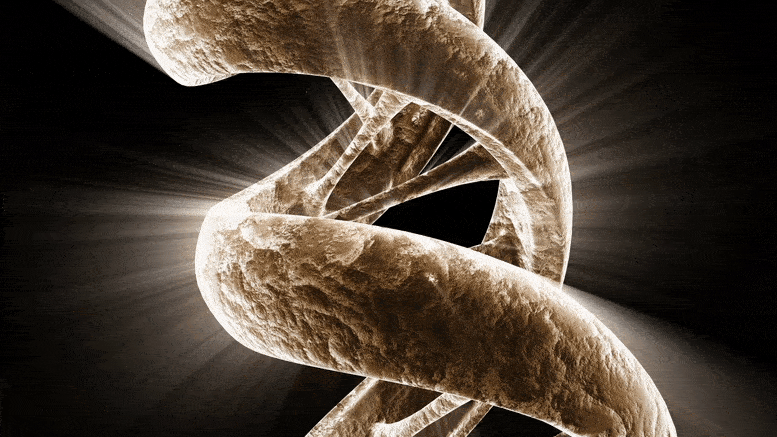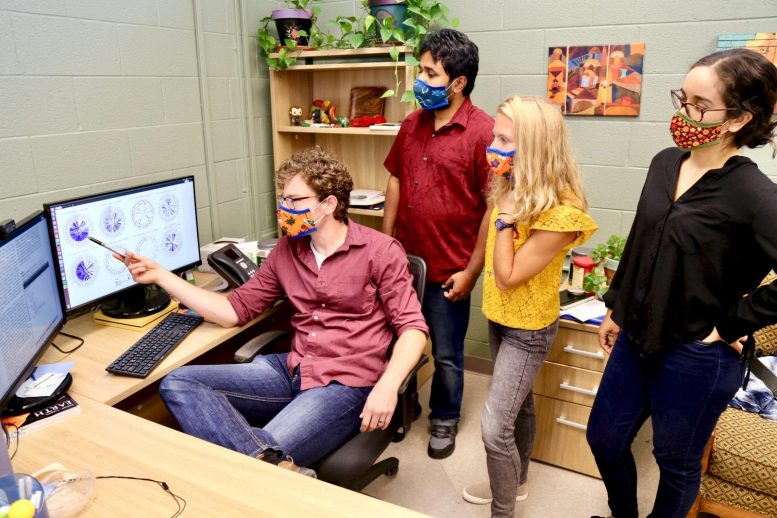
Viruses are tiny invaders that cause a wide range of diseases, from rabies to tomato spotted wilt virus and, most recently, COVID-19 in humans. But viruses can do more than elicit sickness — and not all viruses are tiny.
Large viruses, especially those in the nucleo-cytoplasmic large DNA virus family, can integrate their genome into that of their host — dramatically changing the genetic makeup of that organism. This family of DNA viruses, otherwise known as “giant” viruses, has been known within scientific circles for quite some time, but the extent to which they affect eukaryotic organisms has been shrouded in mystery — until now.
“Viruses play a central role in the evolution of life on Earth. One way that they shape the evolution of cellular life is through a process called endogenization, where they introduce new genomic material into their hosts. When a giant virus endogenizes into the genome of a host algae, it creates an enormous amount of raw material for evolution to work with,” said Frank Aylward, an assistant professor in the Department of Biological Sciences in the Virginia Tech College of Science and an affiliate of the Global Change Center housed in the Fralin Life Sciences Institute.
Mohammad ‘Monir’ Moniruzzaman, a postdoctoral researcher in Aylward’s lab, studies endogenous viral elements, which are fragments or whole sequences of raw viral DNA that have been inserted into the infected host’s genome.
Together, Aylward and Moniruzzaman have recently discovered that endogenous viral elements that originate from giant viruses are much more common in chlorophyte green algae than previously thought.
Their findings will be published today (November 18, 2020) in Nature.

Chlorophytes, a group of green algae, are an important group of photosynthetic organisms that are at the base of the food chain on many ecosystems and produce massive amounts of food and oxygen across the planet. Chlorophytes thrive in our lakes and ponds — and their dynamics with giant viruses as well as their unique evolutionary history, were central to Aylward and Moniruzzaman’s research.
Chlorophyte algae are close relatives of land plants, and studying their interactions with giant viruses may shed some light on the roles that the viruses played during the early evolution of plants.
“We now know that endogenous viral elements are common across chlorophytes, which makes you think that plants might also interact with these giant viruses. There is some data that suggests that some early plants, like moss and ferns, did experience these endogenization events over the evolutionary timeline. But we are not exactly sure about the extent of this phenomenon in other early plants,” said Moniruzzaman, the first author on this published paper.
To learn more about the prevalence of endogenous viral elements in algae, Moniruzzaman and Aylward performed a bioinformatic analysis on the sequenced genomes of different algae groups.
They discovered that 24 of the 65 genomes that were analyzed had some kinds of viral signatures in their genomes, which originated from repeated endogenization of distinct viruses. In one algal organism, Tetrabaena socialis, researchers found that around 10 percent of its genes originated from a virus in the nucleo-cytoplasmic large DNA virus family.
Although the endogenization of viruses have been well studied, studies have mostly been limited to small RNA viruses, such as the human immunodeficiency virus (HIV), the retrovirus that is responsible for causing acquired immunodeficiency syndrome (AIDS).
Aylward and Moniruzzaman’s study is one of the first to put a spotlight on large eukaryotic DNA viruses, which marks a major shift in the field.
Electron micrograph image of a AaV, a giant virus that infects and kills a unicellular alga that causes harmful algae blooms. Giant viruses that belong to the same group as AaV can frequently insert their genomes into the genomes of their hosts. Image courtesy of Chuan Xiao and Yuejiao Xian, University of Texas at El Paso; Steven W. Wilhelm and Eric R. Gann, University of Tennessee, Knoxville.
“These large endogenous viral elements are a lot more common than previously thought. Now that we have a systematic analysis, other researchers are really going to start to pay attention. This study shows that endogenous viral elements are pretty common, and so it might possibly be a common mechanism of genome evolution. I think these results will broaden our view on the role of giant viruses as mere agents of host mortality to significant players in host genome evolution,” said Moniruzzaman.
Now that Moniruzzaman and Aylward have confirmed that endogenization is happening in larger viruses, they wonder what conditions are causing these viruses to inject EVEs into green algae in the first place — and why the hosts show no signs of rejecting them.
“We don’t know what the mechanism is or how the DNA is being maintained, but it is possible that the endogenization is a random, almost accidental process. And once the viral DNA is endogenized, it can alter the evolutionary dynamics of the host, and that it could further influence the evolution of that lineage,” said Aylward.
The idea that there is a potentially beneficial relationship at play between the host and its virus is of particular interest to Moniruzzaman.
“There might be a reason as to why the host is keeping these viral genomes within them. It’s not like these viral genes are causing the hosts to become unsuccessful or unable to survive in the environment. So that’s the thing: Are the endogenous viral elements beneficial to the host? And how are they getting in there and staying in there?” asked Moniruzzaman.
Reference: “Widespread endogenization of giant viruses shapes genomes of green algae” by Mohammad Moniruzzaman, Alaina R. Weinheimer, Carolina A. Martinez-Gutierrez and Frank O. Aylward, 18 November 2020, Nature.
DOI: 10.1038/s41586-020-2924-2
8 Comments
Extremely interesting research.
See if a link with human ecosystem exists and immunity increase and decline with aging and time.
Can be done using computer models and undestanding the ones likely to be most beneficial to the Human and mammalian Biome, at community level and Specific to the Genomes and its variants in humanity , so treatments can be designed for a group, community , and also at a individual level with these “Friendly” immunity enhancing entities. Speed up research efforts.The Human ecosystem may need help against this and future pandemics which appear to be picking up speed.
Not a foregone conclusion, for sure. “So that’s the thing: Are the endogenous viral elements beneficial to the host?” Too early to think of consequences.
the structure of DNA in your figure is wrong
Nice catch!
For some reason people prefer to use a mirror version of the right chiral B-DNA, the most common form. But you can also imagined it stretched (which it isn’t if the twist rate is correct) – eventually it will flip to the other chirality.
Perhaps evolution is NOT a process of random mutations and viral “implants” into DNA are agents of some yet undiscovered higher intelligence in the universe.
Certainly not, and magic ‘higher intelligences’ are excluded by observing flat space since 2018 [Planck collaboration 2018] – energy and work sums to zero over sufficiantly large volumes and is a natural constraint that we can judge against.
A naive model of evolution which captures all dominant mechanisms is the “bathtub model” containing the population allele variation. Mechanisms that add variation and full the tub is mutation, recombination and migration; mechanisms that subtract variation and drain the tub is selection, genetic drift and inbreeding. Horisontal gene transfer from viruses are gene instead of population migration, but works out the same.
The whole universe is natural process [by Planck collaboration above] and specifically biology is it [by Darwin almost two centuries ago]. What else did you expect of nature?!
Left-handed (and ugly) representation of DNA. Do better.
Giant viruses fascinated me before research showed that they were simply good at picking up (and losing) large amounts of genetic material. So they like other viruses mainly coevolve with host clades and likely evolved from cells.
In fact, there are some bacteria that produce plasmids with pore and anchor plate proteins from their polar loci, which remind of the putative pore protein ancestry of viral capsid proteins.